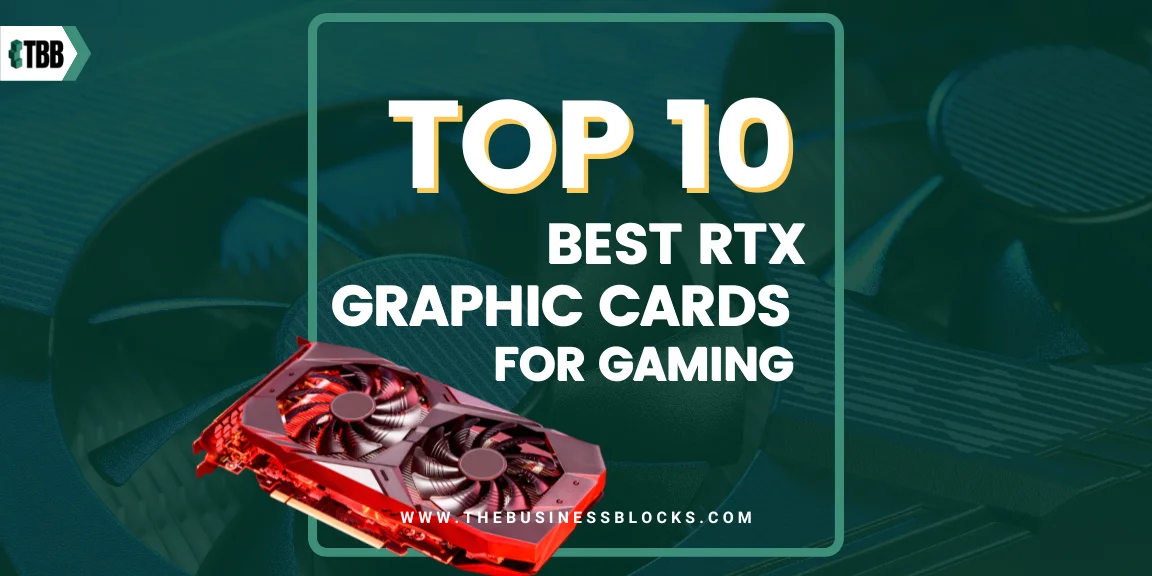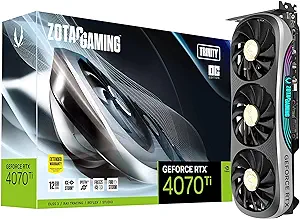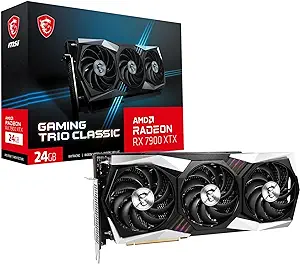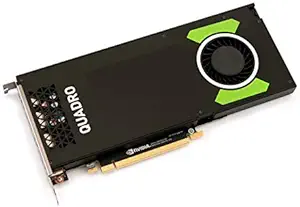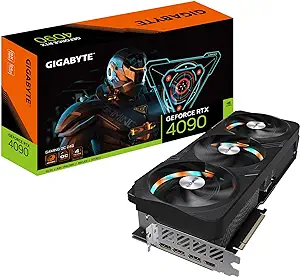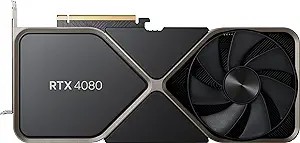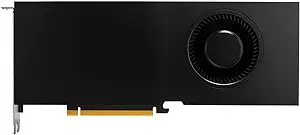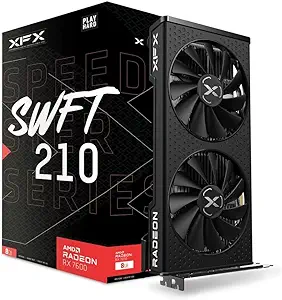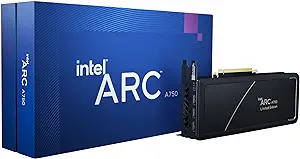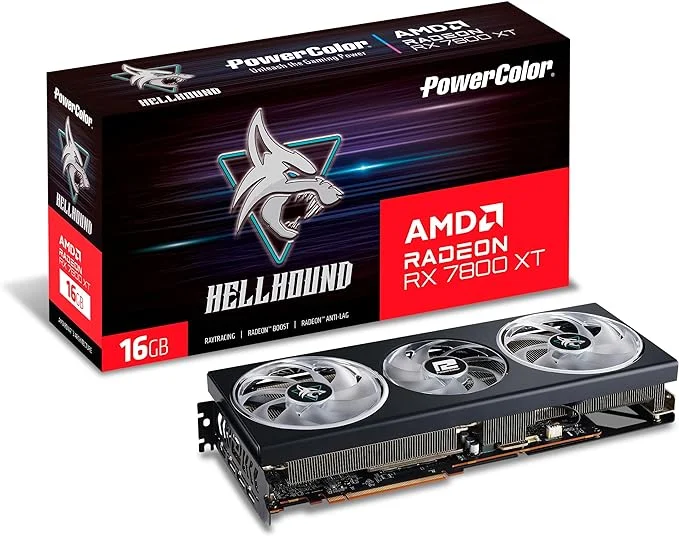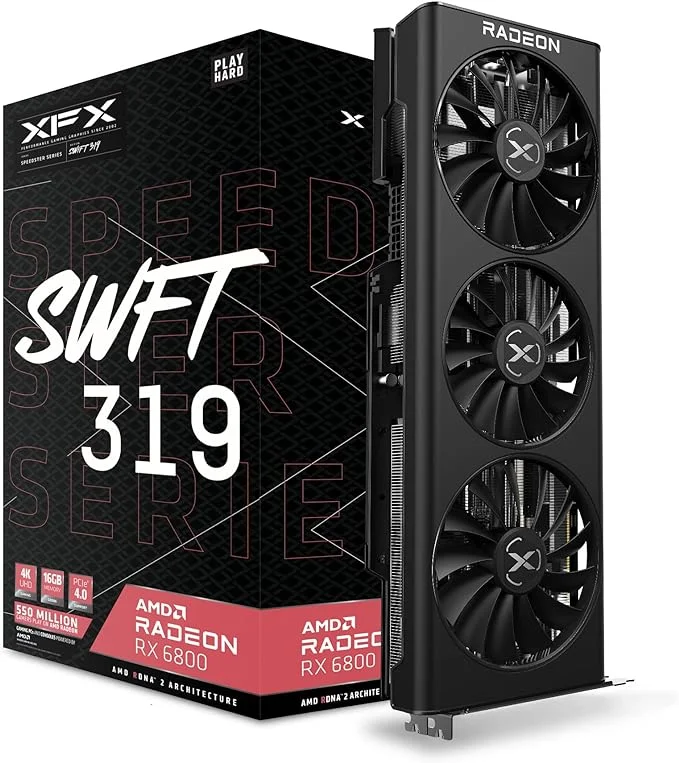In our quest for the ultimate gaming experience, we unveil the “Top 10 Best RTX Graphics Cards for Gaming.” Whether you’re a seasoned gamer seeking unrivaled performance or an enthusiast diving into the realm of real-time ray tracing, this article is your ticket to discovering the crème de la crème of RTX technology. Join us as we explore the powerhouse graphics cards that redefine gaming visuals and elevate your gameplay to new heights.
Ready to level up your gaming experience?
Unveiling a curated selection of the crème de la crème in RTX technology, we’re here to captivate your gaming desires. From blistering framerates to jaw-dropping visuals, these graphics cards promise an odyssey into the next frontier of gaming excellence. Buckle up as we explore the extraordinary lineup that’s set to redefine your gaming experience.
Imagine seamless gameplay, breathtaking graphics, and a competitive edge like never before. The “Top 10 Best RTX Graphics Cards for Gaming” is not just a guide; it’s a roadmap to transforming your gaming rig into a powerhouse. Get ready to desire the unmatched, crave the exceptional, and elevate your gaming aspirations.
Explore, and choose the RTX graphics card that aligns with your gaming dreams.
What are RTX Graphic Cards?
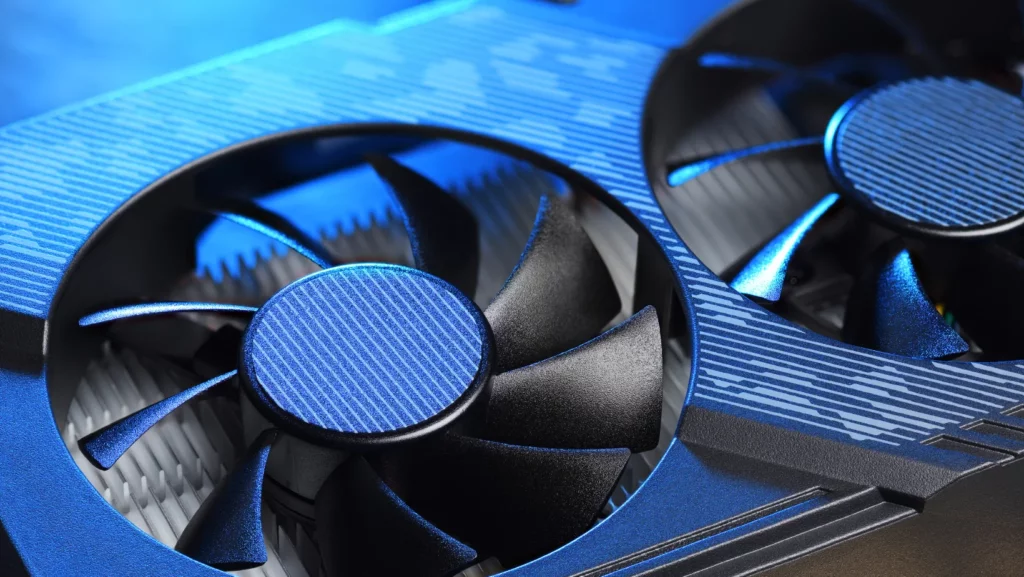
RTX graphic cards are a series of graphics processing units (GPUs) developed by NVIDIA that feature Real-Time Ray Tracing (RTX) technology. Real-Time Ray Tracing is an advanced rendering technique that simulates the behavior of light to achieve more realistic and immersive graphics in real-time applications, particularly in gaming and content creation.
Key features of RTX graphic cards include:
Real-Time Ray Tracing:
The defining feature of RTX cards is their ability to perform real-time ray tracing, a rendering method that simulates the path of light rays as they interact with virtual objects. This results in more accurate reflections, shadows, and lighting effects in digital environments.
Tensor Cores:
RTX cards are equipped with Tensor Cores, which are specialized processing units designed for artificial intelligence (AI) tasks. Tensor Cores play a crucial role in features like DLSS (Deep Learning Super Sampling), an AI-driven technique that enhances image quality and performance.
Advanced Graphics Technologies:
RTX cards support a range of advanced graphics technologies, including variable-rate shading, mesh shading, and other optimizations that contribute to improved gaming performance and visual quality.
CUDA Cores:
Like previous generations of NVIDIA GPUs, RTX cards include CUDA cores for parallel processing. These cores handle a variety of tasks, including graphics rendering, physics simulations, and general computing tasks.
High Performance:
RTX cards are known for their high performance, making them suitable for demanding applications such as gaming, 3D rendering, video editing, and other graphics-intensive tasks.
GDDR6 Memory:
RTX cards typically use GDDR6 memory, providing high bandwidth for quick access to textures and other graphics-related data.
Popular models in the RTX series include the RTX 20 series (e.g., RTX 2080 Ti, RTX 2070) and the RTX 30 series (e.g., RTX 3080, RTX 3070), each offering improved performance and features compared to their predecessors. These GPUs have had a significant impact on the gaming and graphics industry, pushing the boundaries of what is possible in terms of visual fidelity and real-time rendering.
What does RTX do for gaming?
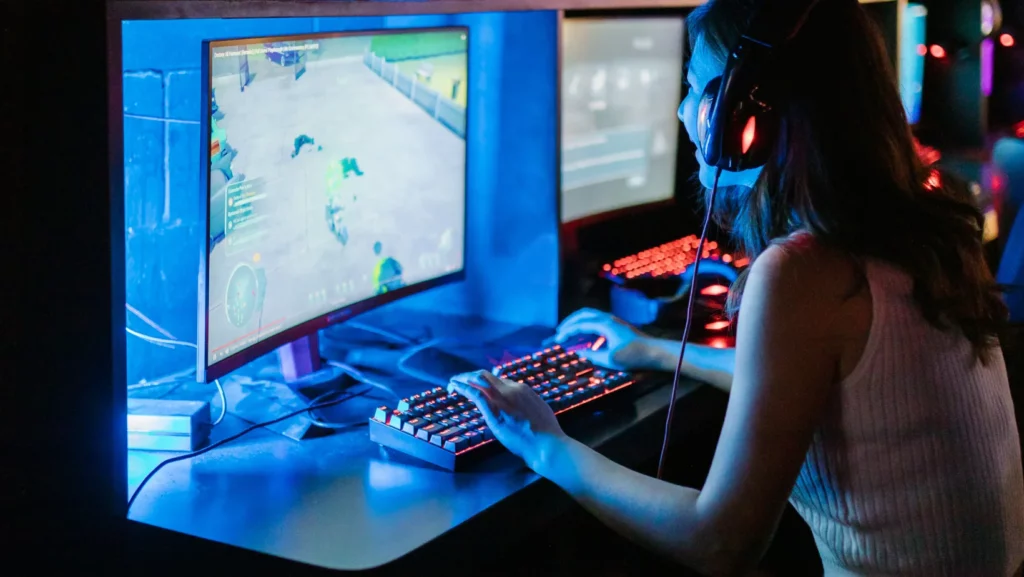
RTX technology brings several advancements to gaming, enhancing the overall gaming experience through its unique features:
Real-Time Ray Tracing:
The standout feature of RTX technology is real-time ray tracing. This rendering technique simulates the behavior of light rays in a virtual environment, creating realistic reflections, accurate shadows, and dynamic lighting effects. In gaming, this results in more lifelike and visually stunning graphics.
Improved Visual Fidelity:
Real-time ray tracing significantly improves the visual fidelity of games. It adds a layer of realism by accurately replicating how light interacts with surfaces and objects, leading to more immersive environments and a heightened sense of presence in the virtual world.
DLSS (Deep Learning Super Sampling):
RTX cards incorporate Tensor Cores that power DLSS, an AI-driven technology. DLSS leverages machine learning to upscale lower-resolution images, providing a balance between improved performance and enhanced image quality. Gamers can enjoy higher frame rates without sacrificing visual clarity.
High Performance in Modern Games:
RTX cards are designed to handle the graphical demands of modern games, offering high performance and smooth gameplay in titles that support real-time ray tracing. Gamers can enjoy the latest AAA titles with advanced graphics features at optimal frame rates.
Advanced Graphics Technologies:
RTX cards support various advanced graphics technologies, such as variable-rate shading and mesh shading. These features contribute to better performance by optimizing the rendering process, ensuring that resources are allocated efficiently.
Immersive Lighting and Reflections:
Real-time ray tracing enhances lighting effects and reflections, making virtual worlds more dynamic and realistic. From sunlight casting accurate shadows to reflective surfaces mirroring the environment, RTX technology elevates the level of detail in gaming environments.
Future-Proofing:
As more game developers embrace real-time ray tracing and other RTX features, owning an RTX card provides a degree of future-proofing. Gamers can enjoy upcoming titles with cutting-edge graphics and features that take full advantage of RTX technology.
While the initial adoption of RTX features required developers to optimize their games, an increasing number of titles now support real-time ray tracing and other RTX technologies. As game developers continue to leverage these capabilities, RTX promises to play a pivotal role in shaping the future of gaming visuals and realism.
Top 10 Best RTX Graphic Cards for Gamers
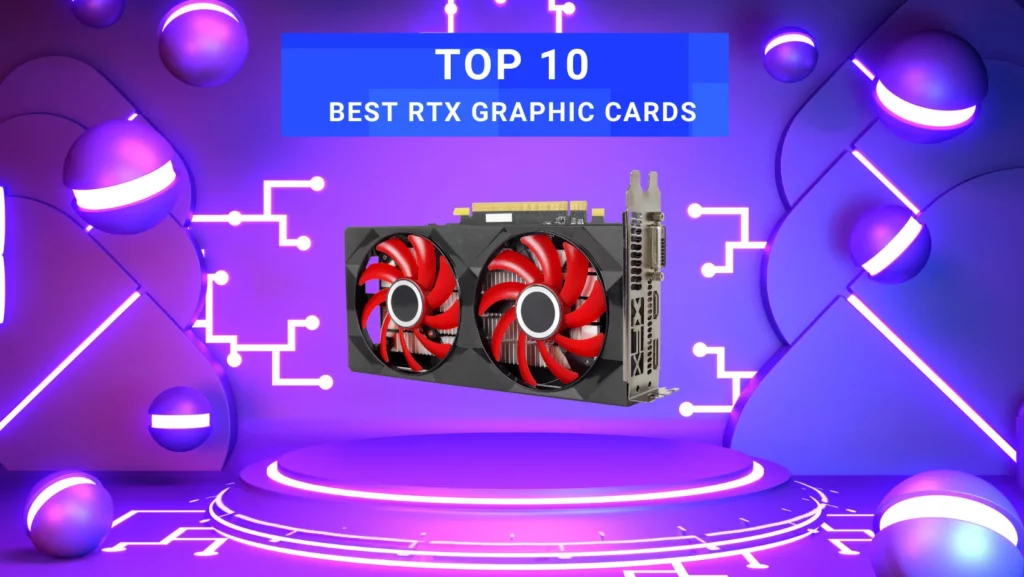
From the adrenaline-pumping framerates to the immersive realism of real-time ray tracing, this curated list is your guide to the elite arsenal of graphics powerhouses designed to redefine the very essence of gaming.
1. ZOTAC Gaming GeForce RTX 4070 Ti
Step into the future of gaming supremacy with the ZOTAC Gaming GeForce RTX 4070 Ti Trinity OC DLSS 3, a juggernaut among graphics cards. The ZOTAC Gaming GeForce RTX 4070 Ti Trinity OC DLSS 3 is not just a graphics card; it’s a symphony of technology and design, offering a glimpse into the future of gaming innovation. Let’s explore the key aspects that make this powerhouse a game-changer:
Performance Unleashed:
Embrace the next era of gaming with a boost clock reaching an impressive 2625 MHz, 12GB of lightning-fast GDDR6X memory running on a 192-bit bus at 21 Gbps, and the latest PCIE 4.0 support. The amalgamation of these specifications ensures not just high frame rates, but an immersive gaming experience that pushes the boundaries of what’s possible.
Advanced Cooling Mastery:
The ZOTAC Trinity OC doesn’t just deliver raw power; it keeps its cool with IceStorm 2.0 Advanced Cooling. Three 90mm fans, Active Fan Control, and the innovative FREEZE Fan Stop technology collaborate to maintain optimal temperatures. Complete with a metal backplate and bundled GPU support stand, it’s a testament to ZOTAC’s commitment to both performance and aesthetics.
Visual Brilliance in Every Pixel:
Designed for the most discerning eyes, the card is 8K Ready and 4 Display Ready, ensuring that every frame is a masterpiece. With HDCP 2.3 compliance, VR readiness, and a suite of advanced features such as DirectX 12 Ultimate, Vulkan RT API, Vulkan 1.3, and OpenGL 4.6, this graphics card is a gateway to a visual realm that blurs the line between reality and virtual worlds.
Spectra 2.0 RGB Elegance:
Elevate your gaming rig aesthetics with Spectra 2.0 ARGB Lighting, allowing you to customize the lighting to match your setup. The attention to detail extends beyond visuals, with a comprehensive connectivity suite including 3 x DisplayPort 1.4a and 1 x HDMI 2.1a, ensuring seamless integration with various display setups and accessories.
PROS
- DLSS 3 Technology.
- High-End Specifications.
- Advanced Cooling System.
- Visual Features and Connectivity.
- Aesthetically Pleasing Design.
CONS
- Higher power requirements.
- Availability Challenges.
- Premium Price Tag.
2. MSI Gaming Radeon RX 7900
Experience gaming at its zenith as the MSI Gaming Radeon RX 7900 XTX Gaming Trio Classic 24G ushers in a new era of visual fidelity and performance, promising a sensory feast for gamers and content creators alike. This powerhouse promises to redefine gaming visuals with its remarkable specifications and cutting-edge features:
AMD RX 7900 XTX Chipset:
The beating heart of this graphics marvel is the AMD RX 7900 XTX chipset. Leveraging the latest RDNA 3 architecture, this chipset is designed to deliver unparalleled gaming performance, bringing a new level of realism to virtual worlds.
Impressive Boost Clock of 2500 MHz:
Unleashing a boost clock of 2500 MHz, the MSI Gaming Radeon RX 7900 XTX Gaming Trio Classic 24G ensures that every frame is rendered with exceptional speed and precision. This formidable clock speed contributes to a seamless gaming experience, especially in graphics-intensive titles.
Generous 24GB GDDR6 Video Memory and MSI’s Torx Fan 4 Cooling Solution:
Elevate your gaming and content creation endeavors with a massive 24GB of GDDR6 video memory. Plus, with its advanced fan blade designs and a focus on efficient heat dissipation, this cooling system ensures that the RX 7900 XTX Gaming Trio Classic 24G remains cool under demanding workloads and extended gaming sessions.
384-Bit Memory Interface and Versatile Outputs:
The 384-bit memory interface enhances data transfer rates, promoting efficient communication between the GPU and video memory. On the connectivity front, the graphics card boasts three DisplayPort (v2.1) outputs and an HDMI 2.1 port, providing a versatile array of options for multi-monitor setups and high-resolution displays.
PROS
- Powerful RDNA 3 Architecture.
- High Boost Clock and Rendering Speed.
- Generous 24GB GDDR6 Video Memory.
- 384-bit Memory Interface and Versatile Outputs.
- Effective Torx Fan 4 Cooling Solution.
CONS
- Power Consumption.
- Availability and Pricing.
- Potential Noise Levels.
3. PNY TECHNOLOGIES Nvidia Quadro P4000
Enter the realm of professional graphics prowess with the PNY TECHNOLOGIES Nvidia Quadro P4000 – heralded as the world’s most powerful single-slot professional graphics card. Engineered for precision and efficiency, this graphics powerhouse is a testament to cutting-edge technology, making it a cornerstone for professionals seeking unparalleled graphics performance. Have a closer look:
Pascal GPU Architecture:
At the core of the Quadro P4000 lies NVIDIA’s Pascal GPU Architecture, a technological marvel known for its efficiency and performance. With an array of CUDA cores and advanced GPU capabilities, the Pascal architecture ensures seamless rendering and accelerated workflows for professionals engaged in design, animation, and content creation.
Simultaneous Multi-Projection:
Elevate your multi-display setups to new heights with Simultaneous Multi-Projection technology. This feature enables the Quadro P4000 to project multiple views from a single GPU, providing enhanced realism and accuracy for complex visualizations.
Pascal Dynamic Load Balancing:
Unleashing the power of Pascal Dynamic Load Balancing, the Quadro P4000 optimizes resource allocation for dynamic workloads. This intelligent balancing ensures that the GPU efficiently distributes processing power based on the demands of various tasks, resulting in consistent performance across diverse applications.
Single-Slot Form Factor:
Redefining expectations, the Quadro P4000 stands out as the world’s most powerful single-slot professional graphics card. This compact form factor allows professionals to harness immense graphics capabilities without compromising space efficiency.
PROS
- Professional-Grade Performance.
- Simultaneous Multi-Projection Technology.
- Pascal Dynamic Load Balancing.
- Single-Slot Form Factor.
- Certified Driver Support.
CONS
- Limited Gaming Driver Support.
- Higher power requirements.
4. GIGABYTE GeForce RTX 4090
Immerse yourself in the epitome of graphics supremacy with the GIGABYTE GeForce RTX 4090 Gaming OC 24G Graphics Card. Crafted for gaming enthusiasts and content creators alike, this powerhouse is a testament to innovation, featuring NVIDIA’s Ada Lovelace architecture and a host of advanced technologies that redefine visual excellence. Let’s explore the key features that make this graphics card a true powerhouse:
NVIDIA Ada Lovelace Streaming Multiprocessors:
Unleash unparalleled performance and power efficiency with the presence of NVIDIA Ada Lovelace Streaming Multiprocessors. Experience up to 2x the performance and power efficiency, ensuring a seamless and responsive gaming experience for even the most demanding titles.
4th Generation Tensor Cores:
Elevate your AI-powered applications with the 4th Generation Tensor Cores. Enjoy up to 2x the AI performance, enabling advanced features like AI-driven rendering, image upscaling, and other machine learning tasks. The GPU becomes a powerhouse for AI-driven applications, providing a boost in both creativity and productivity.
3rd Generation RT Cores:
Embrace the future of gaming visuals with the 3rd Generation RT Cores. Real-time ray tracing takes center stage, delivering up to 2x the ray tracing performance. Witness lifelike reflections, accurate shadows, and dynamic lighting effects that bring virtual worlds to unprecedented levels of realism.
Powered by GeForce RTX 4090 and Integrated with 24GB GDDR6X Memory:
At the heart of this graphics marvel is the GeForce RTX 4090, a powerhouse that forms the backbone of cutting-edge gaming experiences. Plus, with a generous 24GB of GDDR6X memory, the expansive 384-bit memory interface ensures quick access to high-resolution textures and data, providing the bandwidth required for handling complex scenes and large datasets.
PROS
- Advanced Cooling System.
- Exceptional Performance.
- Generous VRAM Capacity.
- Generous VRAM Capacity.
- Dual BIOS and Anti-sag Bracket.
CONS
- Potential Noise Levels.
- Price Point.
- Power Consumption.
5. NVIDIA – GeForce RTX 4080
Prepare to elevate your gaming and creative experiences to unprecedented heights with the NVIDIA GeForce RTX 4080. This graphics powerhouse is not just a GPU; it’s a technological marvel designed to redefine the boundaries of visual computing. Let’s delve into the key features that make the RTX 4080 a game-changer in the world of graphics processing:
Powered by NVIDIA GeForce RTX 4080 (16GB):
At the heart of this graphics marvel is the NVIDIA GeForce RTX 4080, a powerhouse of innovation and performance. With 16GB of dedicated video memory, the RTX 4080 is poised to deliver an immersive and seamless experience, whether you’re gaming, designing, or engaging in content creation.
PCI Express 4.0 Compatibility:
The RTX 4080 embraces the cutting-edge PCI Express 4.0 technology, providing enhanced data transfer rates for faster and more efficient communication between the GPU and the rest of the system. Moreover, it maintains compatibility with earlier PCI Express 3.0 systems, ensuring accessibility across a range of setups.
9,728 NVIDIA CUDA Cores and Dedicated Ray Tracing Cores:
Unleash the computational prowess of the RTX 4080 with its 9,728 NVIDIA CUDA Cores, facilitating parallel processing for graphics rendering, simulations, and more. Additionally, the inclusion of dedicated Ray Tracing Cores propels your visual experiences to the next level, delivering realistic lighting, shadows, and reflections in real time.
Microsoft DirectX 12 Ultimate and Vulkan RT APIs:
The RTX 4080 supports the latest graphics technologies, including Microsoft DirectX 12 Ultimate. This ensures compatibility with cutting-edge gaming titles and applications that leverage advanced graphics features. Vulkan RT APIs further enhance performance and flexibility, providing a foundation for a broad range of graphics-intensive applications.
PROS
- Cutting-Edge Performance.
- Innovative CUDA and Ray Tracing Cores.
- PCI Express 4.0 Compatibility.
- DirectX 12 Ultimate and Vulkan RT API Support.
- Future-Proofing with 16GB GDDR6X Memory.
CONS
- High Power Consumption.
- Potentially High Price Point.
- Availability Challenges.
6. PNY TECHNOLOGIES NVIDIA RTX A5000
Step into the realm of professional graphics excellence with the PNY TECHNOLOGIES NVIDIA RTX A5000. This graphics powerhouse is meticulously crafted for demanding professional workflows, offering unparalleled performance and cutting-edge features that redefine the standards of visual computing. Let’s delve into the key specifications that make the RTX A5000 a cornerstone in the world of professional graphics:
8192 Optimized CUDA Cores, 27.8 TFLOPS:
At the core of the RTX A5000 lies an impressive array of 8192 optimized CUDA Cores, providing a foundation for efficient parallel processing. With a remarkable computational capacity of 27.8 TFLOPS, this graphics card is poised to handle complex simulations, rendering, and professional applications with unparalleled speed and precision.
256 Third Generation Tensor Cores, 222.2 TFLOPS:
Elevate your AI-driven workflows with the inclusion of 256 third-generation Tensor Cores. With a staggering 222.2 TFLOPS of AI performance, the RTX A5000 becomes a powerhouse for tasks such as deep learning, neural network training, and other artificial intelligence applications, ensuring optimal efficiency and productivity.
64 Second Generation RT Cores, 54.2 TFLOPS:
Realize the full potential of ray tracing with 64 second-generation RT Cores, delivering a remarkable 54.2 TFLOPS of ray tracing performance. This ensures a heightened level of realism in visualizations, simulations, and 3D rendering, bringing accurate reflections, shadows, and lighting effects to professional projects.
NVLink for GPU Memory Pooling and Performance Scaling:
Unlock unprecedented levels of performance and memory pooling with NVLink technology. The RTX A5000 supports NVLink, allowing multiple GPUs to work in tandem, pooling their memory resources and scaling performance. This is particularly beneficial for large-scale simulations and memory-intensive tasks in professional applications.
PROS
- Exceptional CUDA and Tensor Core Performance.
- High Ray Tracing Capability.
- Dual-Slot Width and Full-Length Form Factor.
- NVLink Technology for Memory Pooling and Scaling.
- Professional-Grade Reliability.
CONS
- High Power Consumption.
- Premium Price Point.
- Potential Overkill for Standard Workloads.
7. XFX Speedster SWFT210 Radeon RX 7600
The XFX Speedster SWFT210 Radeon RX 7600 is a gateway to a heightened gaming experience. Designed for enthusiasts seeking exceptional performance, this graphics powerhouse is equipped with AMD RDNA 3 architecture, ensuring cutting-edge visuals and smooth gameplay. Let’s explore the key features:
Chipset: AMD RX 7600:
At the core of the SWFT210 graphics card lies the potent AMD RX 7600 chipset. Engineered for optimal gaming performance, this chipset, based on the latest RDNA 3 architecture, delivers a blend of power efficiency and graphics prowess to meet the demands of modern gaming and content creation.
Memory: 8GB GDDR6:
Immerse yourself in a world of high-speed, high-capacity memory with 8GB of GDDR6. This memory configuration ensures snappy performance and responsiveness, handling graphics-intensive tasks, large textures, and high-resolution gaming with ease.
XFX SWFT Dual Fan Cooling Solution:
Keep temperatures in check even during intense gaming sessions with the XFX SWFT Dual Fan Cooling Solution. This advanced cooling mechanism is designed to dissipate heat efficiently, ensuring optimal thermal performance and system stability while maintaining a quieter gaming environment.
Boost Clock: Up to 2655 MHz:
Unleash the full potential of the RX 7600 with an impressive boost clock of up to 2655 MHz. This elevated clock speed contributes to higher frame rates, reduced input lag, and an overall smoother gaming experience. Whether you’re tackling graphically demanding titles or engaging in creative workloads, the RX 7600 is poised to deliver exceptional performance.
PROS
- Powerful RDNA 3 Architecture.
- 8GB GDDR6 Memory.
- Efficient XFX SWFT Dual Fan Cooling.
- High Boost Clock (Up to 2655 MHz).
- Versatile Connectivity.
CONS
- Potential Power Consumption.
- Premium Price Point.
- Possibly Large Physical Size.
8. Intel Arc A750
The Intel Arc A750 Limited Edition 8GB PCI Express 4.0 Graphics Card is more than just a component; it’s a testament to Intel’s commitment to pushing the boundaries of graphics technology. Designed to deliver exceptional graphics performance, this limited edition GPU is poised to redefine your expectations of gaming, content creation, and beyond. Let’s delve into the key details:
Intel Arc A750 8GB PCI Express 4.0 Graphics Card:
At the heart of this limited edition graphics card lies the Intel Arc A750 GPU, designed to provide a balance of power and efficiency. With 8GB of video memory and PCI Express 4.0 support, it ensures a seamless experience for gaming, creative workloads, and graphics-intensive applications.
Compact Package Dimensions:
The Intel Arc A750 Limited Edition comes in a compact package with dimensions measuring 17.519L x 11.179W x 6.33H inches. This makes it suitable for various PC setups, providing flexibility in installation and integration into different system configurations.
Substantial Package Weight:
Weighing in at 4.64 pounds, the Intel Arc A750 Limited Edition reflects the robust build and quality construction of this graphics card. The substantial weight underscores the premium materials and components used, contributing to its durability and performance.
Single Unit Package Quantity:
The Intel Arc A750 Limited Edition is packaged as a single unit, emphasizing its exclusivity and individuality. Each unit represents a unique opportunity to harness the power of Intel’s Arc graphics architecture, making it a coveted addition to any enthusiast’s PC setup.
PROS
- Cutting-Edge Architecture.
- PCI Express 4.0 Support.
- Limited Edition Exclusivity.
- Compact Form Factor.
- Product Quality and Durability.
CONS
- May Not Outperform Higher-End GPUs.
- 8GB Video Memory Limit.
9. PowerColor Hellhound AMD Radeon RX 7800
Unleash the beast within your gaming rig with the PowerColor Hellhound AMD Radeon RX 7800 XT 16GB GDDR6 Graphics Card. Designed for gamers and enthusiasts who demand uncompromising performance, this graphics powerhouse is poised to deliver stunning visuals, smooth gameplay, and an immersive computing experience. Let’s explore the key features that make the Hellhound RX 7800 XT a formidable contender:
Video Memory: 16GB GDDR6:
Immerse yourself in a world of rich textures and detailed graphics with a massive 16GB of GDDR6 video memory. The Hellhound RX 7800 XT ensures that you have ample video memory for handling high-resolution textures, complex scenes, and multitasking in content creation applications.
Stream Processor: 3840 Units:
Equipped with a staggering 3840 stream processor units, the Hellhound RX 7800 XT is optimized for parallel processing, ensuring efficient graphics rendering and performance. This abundance of stream processors enhances the GPU’s capability to handle demanding gaming scenarios and content creation tasks.
Game Clock and Boost Clock Options:
Tailor your gaming experience with customizable clock speeds. The Hellhound RX 7800 XT offers a dynamic range of clock speeds, with a Game Clock of 2210 MHz (OC) or 2170 MHz (Silent) and a Boost Clock of 2520 MHz (OC) or 2475 MHz (Silent). Choose the clock speeds that best suit your performance preferences and noise tolerance.
Memory Clock at 19.5 Gbps:
Elevate your gaming experience with a lightning-fast memory clock of 19.5 Gbps. This high memory clock ensures rapid access to graphics data, reducing latency and contributing to smoother frame rates, making the Hellhound RX 7800 XT an ideal choice for high-performance gaming.
PROS
- Ample 16GB GDDR6 Video Memory.
- High Stream Processor Count (3840 Units).
- Customizable Clock Speeds.
- High Memory Clock (19.5 Gbps).
- Advanced Cooling Solution.
CONS
- Premium Price.
- Large Physical Size.
- Power Consumption.
10. XFX Speedster SWFT319 ,Radeon RX 6800
Prepare to elevate your gaming experience to new heights with the XFX Speedster SWFT319 Radeon™ RX 6800 Core Gaming Graphics Card. Engineered for uncompromising performance, this graphics powerhouse is equipped with AMD RDNA™ 2 architecture. Let’s delve into the key features:
Chipset: AMD RX 6800:
At the heart of the SWFT319 graphics card lies the potent AMD RX 6800 chipset. Leveraging the power of RDNA™ 2 architecture, this chipset delivers an unparalleled gaming experience, ensuring high frame rates and stunning visuals for the most demanding gaming titles.
Memory: 16GB GDDR6:
Immerse yourself in the world of high-speed, high-capacity graphics memory with a substantial 16GB of GDDR6. This configuration ensures smooth rendering of high-resolution textures, seamless multitasking, and optimal performance in graphics-intensive applications.
XFX SWFT 319 Triple Fan Cooling:
The XFX SWFT 319 Triple Fan cooling solution is engineered to keep temperatures in check during intense gaming sessions. With its advanced design, this cooling solution dissipates heat efficiently, maintaining optimal thermal performance and contributing to a quieter gaming environment.
Boost Clock: Up To 2105MHz:
Unleash the full potential of the RX 6800 Core with an impressive boost clock of up to 2105MHz. This elevated clock speed ensures that the graphics card can deliver high frame rates and responsive performance, making it ideal for gaming enthusiasts and content creators alike.
PROS
- Powerful RDNA™ 2 Architecture.
- Generous 16GB GDDR6 Memory.
- Efficient XFX SWFT 319 Triple Fan Cooling.
- High Boost Clock (Up To 2105MHz).
- RDNA™ 2 Features and Technologies.
CONS
- Premium Price.
- Availability Challenges.
As we have completed the list of the Top 10 Best RTX Graphic Cards for Gaming, ensure to consider your specific gaming needs, system compatibility, and budget constraints. Evaluate each graphics card based on its performance, features, and price-to-performance ratio to find the perfect match for your gaming setup. Keep in mind that technology evolves, so stay updated with the latest releases and reviews to make an informed decision for an optimized gaming experience.
Tips for Selecting the Right RTX Graphic Card for Gaming
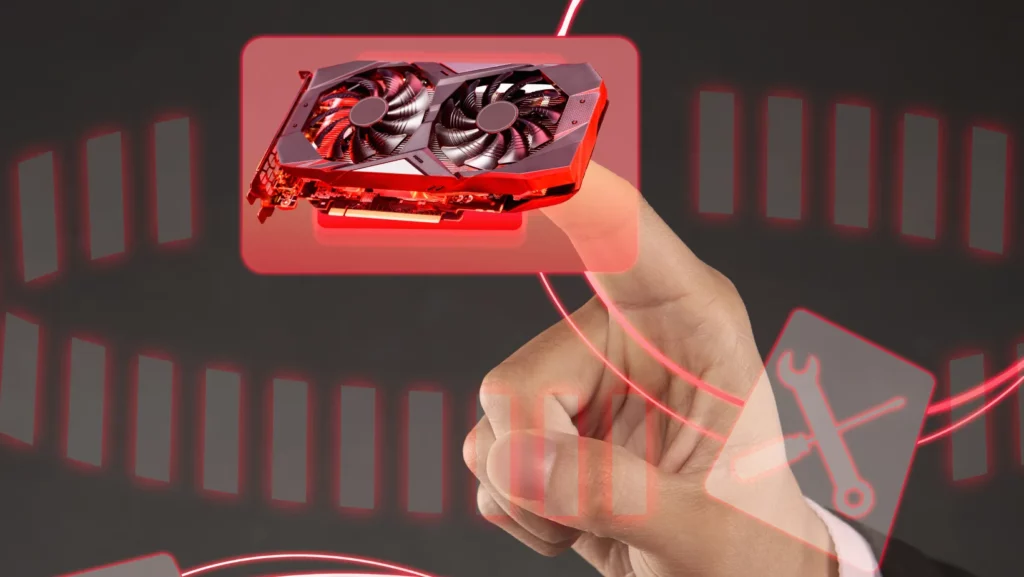
Selecting the right RTX graphics card for gaming is crucial to ensure an optimal gaming experience.
Here are some tips to help you make an informed decision:
- Performance Considerations: Evaluate the performance of the RTX graphics card based on your gaming preferences and the types of games you intend to play. Consider factors such as frame rates, resolution, and graphic settings to ensure the card meets your performance expectations.
- Budget Planning: Define your budget before starting the selection process. RTX graphics cards come in various price ranges, so identifying your budget constraints will help narrow down your options and prevent overspending.
- System Compatibility: Ensure that the chosen RTX graphics card is compatible with your gaming rig. Check factors like the available PCIe slots, power supply unit (PSU) requirements, and physical dimensions to guarantee seamless integration without any hardware limitations.
- Memory Size and Type: Consider the video memory (VRAM) size and type for handling high-resolution textures and complex scenes. Games with larger textures or those involving content creation may benefit from graphics cards with higher VRAM.
- Ray Tracing and DLSS Support: If you value realistic lighting and reflections in games, look for RTX cards with ray tracing capabilities. Additionally, consider cards that support Deep Learning Super Sampling (DLSS) for improved performance in ray-traced games.
- Future-Proofing: Anticipate future gaming demands by choosing a graphics card that offers a good balance of current and potential future performance. This ensures your system remains relevant for upcoming games and software updates.
- Reviews and Benchmarks: Before making a final decision, consult reviews and benchmarks for the specific RTX card you are considering. Real-world performance insights from other users can provide valuable information and help you make an informed choice.
- Brand Reputation and Warranty: Consider the reputation of the graphics card manufacturer. Established brands often provide better customer support and warranties. Check customer reviews and forums to gauge the reliability and support offered by the brand.
- Connectivity Options: Confirm the connectivity options of the RTX card, including the number and types of ports. Ensure it accommodates your display requirements, whether you use multiple monitors, high refresh rates, or advanced features like G-Sync or FreeSync.
- Stay Informed About New Releases: Graphics card technology evolves rapidly. Stay informed about new RTX releases and updates to make sure you are aware of the latest features and improvements in performance.
By considering these tips, you can confidently select the right RTX graphics card that aligns with your gaming preferences, budget, and system requirements.
Frequently Asked Questions About Top 10 Best RTX Graphic Cards for Gaming
Q: What are the key factors to consider when choosing an RTX graphics card for gaming?
A: Consider factors such as performance, budget, system compatibility, memory size and type, ray tracing and DLSS support, future-proofing, reviews and benchmarks, brand reputation and warranty, and connectivity options.
Q: How do I determine the right RTX graphics card based on my gaming preferences?
A: Evaluate the performance of the graphics card in terms of frame rates, resolution, and graphic settings, keeping in mind the types of games you intend to play.
Q: What is the significance of ray tracing and DLSS in RTX graphics cards?
A: Ray tracing enhances realistic lighting and reflections in games, while DLSS (Deep Learning Super Sampling) can improve performance in ray-traced games by utilizing AI to upscale lower-resolution images.
Q: Why is VRAM size important, and how do I choose the right amount for my gaming needs?
A: VRAM (video memory) size is crucial for handling high-resolution textures. Choose an amount based on the types of games you play and whether you engage in content creation tasks that demand more graphics memory.
Q: How can I ensure the RTX graphics card is compatible with my gaming rig?
A: Check factors such as PCIe slot compatibility, power supply unit (PSU) requirements, and physical dimensions to ensure seamless integration without any hardware limitations.
Final Thoughts
The Top 10 Best RTX Graphic Cards for Gaming present a diverse array of options tailored to meet the dynamic needs of gamers and enthusiasts alike. From powerful GPUs built on cutting-edge architectures to ample VRAM, these graphics cards are designed to deliver exceptional gaming experiences.
When making your selection, consider factors such as performance, budget, system compatibility, and future-proofing to ensure that your chosen RTX card aligns seamlessly with your gaming preferences. Stay informed about the latest releases, explore user reviews, and leverage benchmark data to make a well-informed decision. Whichever card you choose from this elite selection, you’re poised to unlock a new level of visual excellence, responsiveness, and immersion in the world of gaming.

